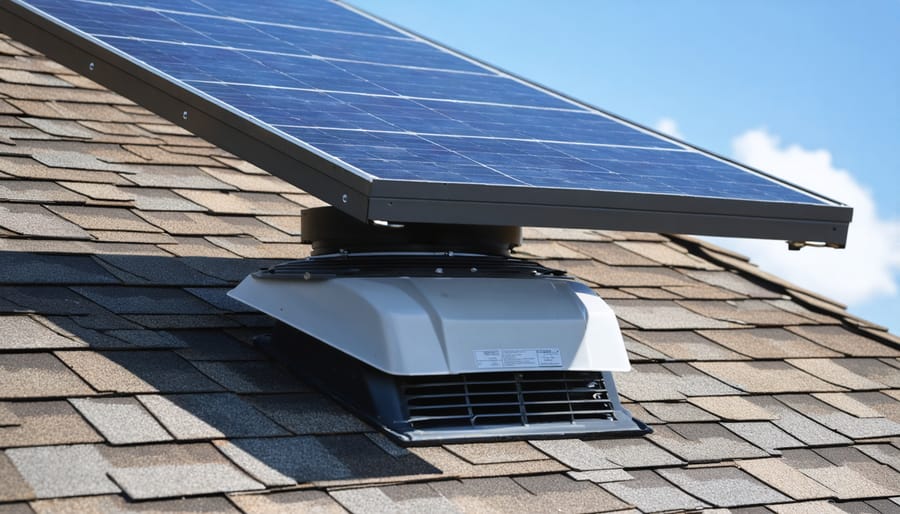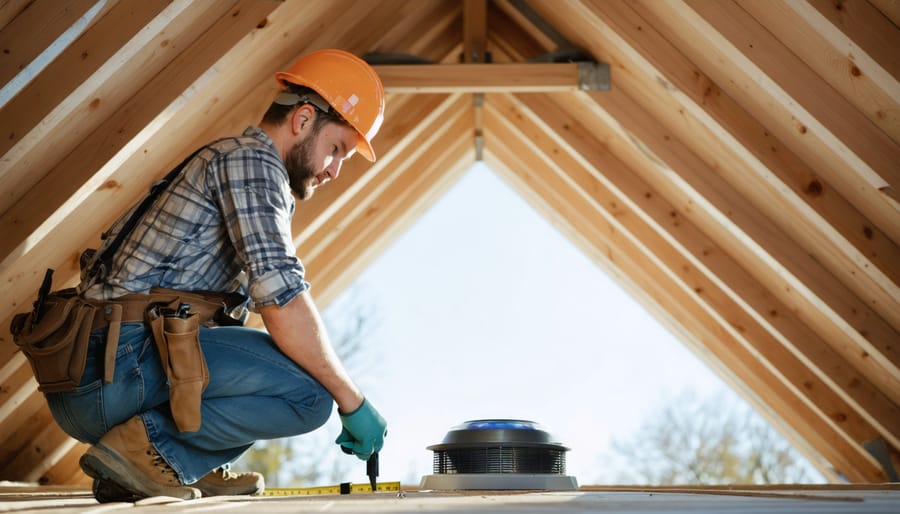Solar Attic Fans: The Truth About Cooling Your Home From Above
Updated:
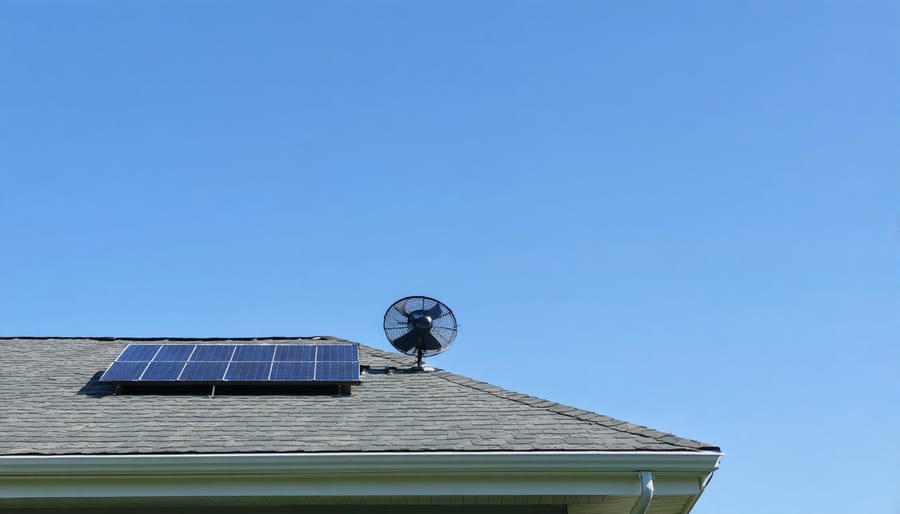
Solar attic fans present a compelling but complex investment for homeowners seeking to reduce energy costs and improve home comfort. Unlike traditional electric attic fans, these solar-powered units operate completely off-grid, converting sunlight into cooling power when you need it most – during peak daylight hours when your attic heats up. While the promise of free operation and lower utility bills sounds attractive, the real value depends heavily on your specific situation. As someone who’s installed and tested multiple solar attic fan systems across different climate zones, I’ve discovered that factors like your local weather patterns, existing insulation levels, and roof configuration play crucial roles in determining whether this $300-600 investment will genuinely pay off. Before you make a decision, let’s examine the concrete data on energy savings, installation requirements, and performance limitations to help you determine if a solar attic fan is truly worth it for your home.
How Solar Attic Fans Actually Work
The Science of Attic Heat
Your attic is like a heat magnet during summer months, and understanding how attic fans work starts with grasping this fundamental principle. As the sun beats down on your roof, temperatures in your attic can soar to a sweltering 150°F or higher! This isn’t just uncomfortable – it’s a real problem for your entire home.
Think of your attic as a warm blanket sitting on top of your living space. When it heats up, that warmth radiates downward, making your air conditioning work overtime to maintain comfortable temperatures below. This heat transfer happens through your ceiling, affecting your home’s temperature and your energy bills.
The problem gets worse because hot air tends to get trapped in your attic. Without proper ventilation, this creates a cycle where heat builds up day after day. Your roof materials can deteriorate faster, your cooling costs increase, and in some cases, this trapped heat can even lead to moisture problems that affect your home’s structural integrity.
I’ve seen firsthand how dramatic this effect can be in homes across different climate zones. During energy audits, I’ve measured attic temperatures that were hot enough to make traditional insulation far less effective.
Solar-Powered Ventilation Basics
Solar attic fans work by harnessing the sun’s energy through a photovoltaic (PV) panel, which converts sunlight directly into electricity. Think of it as a small-scale version of the solar panels you might see on rooftops, but dedicated solely to powering your ventilation fan.
The solar panel connects to a DC motor that drives the fan blades. When sunlight hits the panel, it generates electricity that powers up the motor, causing the fan to spin. The stronger the sunlight, the more power generated, and consequently, the faster the fan spins. This self-regulating nature is actually quite clever – the fan runs fastest during the hottest, sunniest parts of the day when you need the most ventilation.
I recently installed one of these systems in my own attic, and what fascinates me most is that there’s no need for complex wiring or electrical connections. The system is completely self-contained and operates independently from your home’s electrical system. Most models come with everything needed for installation: the solar panel, fan unit, and mounting hardware.
The beauty of this setup is its simplicity and reliability. With no external power needed and very few moving parts, these systems typically require minimal maintenance while providing years of service.
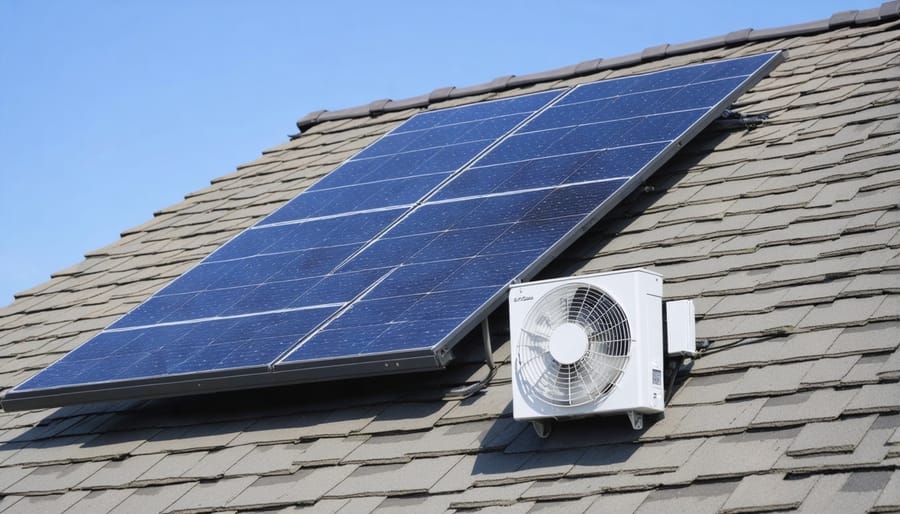
Real Benefits of Solar Attic Fans
Energy Savings Reality Check
Let’s get real about those energy savings claims you might have seen. While solar vs traditional electric fans can make a difference in your energy bills, the actual savings might not be as dramatic as some manufacturers suggest.
In my experience working with homeowners, the typical energy savings from a solar attic fan range from $5 to $25 per month during peak cooling season. This varies significantly based on your location, attic size, and existing insulation quality. A well-insulated home in a moderate climate might see minimal savings, while a poorly insulated home in a hot region could benefit more substantially.
Here’s what I’ve observed: homes with air conditioning systems working overtime to combat heat from poorly ventilated attics tend to see the most noticeable improvements. One of my clients in Arizona reported a 10% reduction in their summer cooling costs after installing a solar attic fan, but their neighbor saw only a 3% difference.
Remember, these fans work best as part of a comprehensive attic ventilation strategy. They’re not a magic solution, but rather one piece of the energy efficiency puzzle. For maximum benefit, combine solar attic fans with proper insulation and other ventilation methods. This approach typically yields better results than relying on the fan alone.
Consider tracking your energy bills before and after installation to measure your actual savings – it’s the best way to understand the real impact on your specific situation.
Impact on Home Comfort
One of the most noticeable benefits of installing a solar attic fan is the immediate impact on your home’s comfort level. When your attic temperature soars during hot summer days, it creates a heat pocket that radiates downward into your living spaces. By actively ventilating this hot air, solar attic fans help maintain a more comfortable temperature throughout your home.
I’ve seen firsthand how effective these fans can be. In my own home, the upstairs bedrooms used to be noticeably warmer than the rest of the house, especially during peak afternoon hours. After installing a solar attic fan, the temperature difference between floors decreased significantly, making the entire house more livable.
Beyond temperature regulation, proper attic ventilation helps prevent moisture buildup, which can lead to a host of comfort-related issues. When warm, humid air gets trapped in your attic, it can create conditions perfect for mold growth and wood rot. These problems not only affect your home’s structural integrity but can also impact indoor air quality and, consequently, your family’s health and comfort.
During winter months, solar attic fans continue to provide benefits by preventing ice dams and reducing condensation. This year-round performance means you’ll experience more consistent indoor temperatures and better overall home comfort, regardless of the season.
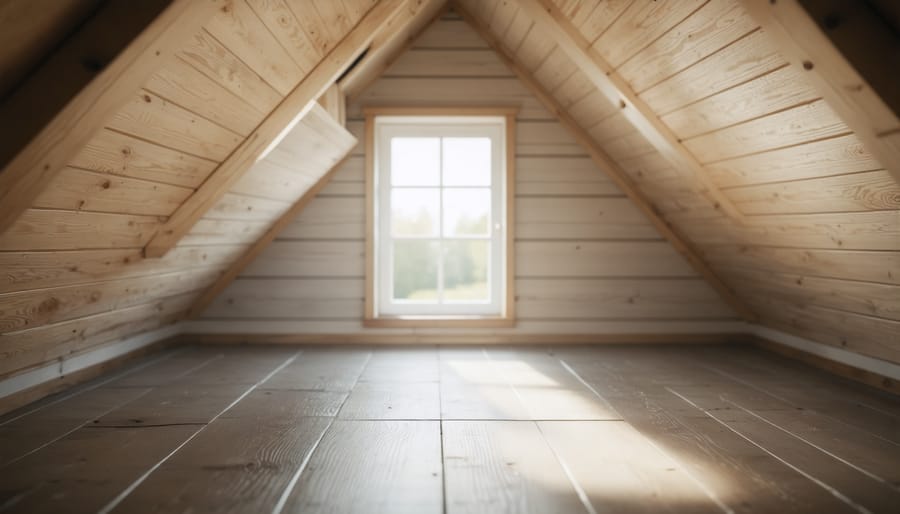
Common Drawbacks and Limitations
While solar attic fans offer numerous benefits, it’s important to consider their limitations before making a purchase. From my experience helping fellow DIYers, I’ve noticed several common drawbacks that might affect their performance and value.
First, solar attic fans are entirely dependent on sunlight, which means they work best during peak daylight hours. Unfortunately, this timing isn’t always ideal since your attic might need ventilation during cloudy days or at night when the fans operate at reduced capacity or not at all. Some homeowners find they need backup power sources or hybrid systems to maintain consistent ventilation.
Installation location can be tricky too. Your roof needs the right orientation and angle to capture sufficient sunlight, and nearby trees or buildings can cast shadows that reduce efficiency. I’ve seen cases where homeowners had to trim trees or adjust their installation plans to get optimal performance.
The fan’s capacity might not be sufficient for larger attics. A single solar attic fan typically covers about 1,200 square feet of attic space, so bigger homes might need multiple units, increasing both cost and installation complexity. Additionally, if your attic already has good passive ventilation through ridge vents or soffit vents, the added benefit of a solar fan might be minimal.
Weather can pose challenges too. Heavy snow can cover solar panels, and severe storms might damage the external components. In regions with frequent harsh weather, maintenance and repair costs could add up over time.
There’s also the issue of backdrafting, particularly in homes with combustion appliances in or near the attic. Strong attic ventilation can potentially interfere with proper exhaust from these appliances, creating safety concerns that need professional assessment.
Lastly, the initial cost might be prohibitive for some homeowners, especially when considering professional installation. While long-term energy savings are possible, the payback period can be longer than expected, particularly in areas with moderate climates where attic ventilation is less critical.
Cost Analysis and ROI
Initial Investment Breakdown
When considering a solar attic fan, understanding the complete financial picture is crucial for making an informed decision. The solar attic fan installation costs typically range from $400 to $900 for a standard unit, but let’s break this down into more manageable pieces.
The fan unit itself usually costs between $200 and $400, depending on the brand and capacity. Premium models with higher CFM (Cubic Feet per Minute) ratings and additional features like thermostats or humidity sensors can push the price up to $600. From my experience helping fellow DIY enthusiasts, I’ve found that mid-range models around $300 offer the best balance of quality and value.
Installation materials add another layer to your initial investment. You’ll need:
– Flashing kit: $30-50
– Wiring supplies: $20-30
– Sealant and mounting hardware: $25-40
– Basic tools (if you don’t already have them): $50-100
If you’re hiring a professional, labor costs typically run between $150 and $300 for a standard installation. However, if you’re comfortable with basic DIY projects and have experience working on your roof, you can save this expense by installing it yourself. Just remember to check local building codes and warranty requirements before deciding on the DIY route.
Remember, these costs are one-time investments, and the long-term savings on energy bills can help offset this initial expense over time.
Long-term Value Assessment
When evaluating the long-term value of a solar attic fan, you need to consider both energy savings and maintenance costs over its lifespan, which typically ranges from 15 to 20 years. Let’s break down the numbers that matter to you as a homeowner.
In terms of energy savings, most households can expect to reduce their cooling costs by 10-20% annually. If your monthly summer cooling bill averages $200, you could save between $20-$40 per month during peak seasons. Over a year, this translates to approximately $160-$320 in savings, depending on your climate and usage patterns.
Maintenance costs are relatively minimal, which is great news for DIY enthusiasts. The solar panel needs occasional cleaning (about twice a year), and the fan motor might need replacement after 10-12 years, costing around $100-150. Since there are no moving parts in the solar panel itself, it’s quite reliable and low-maintenance.
Let’s do some quick math: With an initial investment of $300-600 for a quality solar attic fan, plus potential installation costs if you hire a professional, you could reach the break-even point in 2-4 years. After that, it’s mostly savings in your pocket, minus minimal maintenance expenses.
The environmental benefits are equally impressive – by reducing your AC usage, you’re lowering your carbon footprint while extending the life of your cooling system. It’s a win-win for both your wallet and the planet.
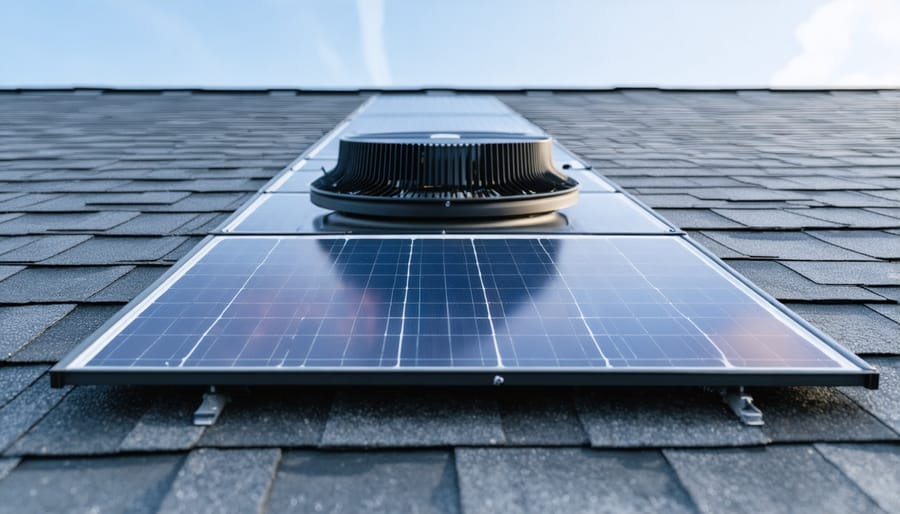
Installation Considerations
Before diving into installation, there are several crucial factors you’ll need to consider to ensure your solar attic fan performs effectively. First, you’ll need to properly size your attic fan based on your attic’s square footage and existing ventilation setup. This isn’t just about buying the biggest fan available – it’s about finding the right balance for your specific space.
Location is another critical consideration. The solar panel needs unobstructed access to sunlight during peak hours. Take time to evaluate your roof’s orientation and check for any shade from nearby trees or structures that might impact performance. I learned this the hard way when installing my first solar attic fan – a nearby oak tree significantly reduced its efficiency until I adjusted the panel’s position.
Roof compatibility is equally important. Most solar attic fans work best on asphalt shingle roofs, but installation methods may vary for metal, tile, or flat roofs. You’ll also need to check your local building codes and HOA regulations, as some areas have specific requirements for roof-mounted solar equipment.
Consider your existing attic ventilation system too. Solar attic fans work best in conjunction with proper intake vents at the eaves. Without adequate intake ventilation, your fan won’t be able to effectively circulate air, regardless of its power rating.
Lastly, think about accessibility for maintenance. While solar attic fans generally require minimal upkeep, you’ll want to ensure you can easily reach the unit to clean the solar panel and check for any issues periodically.
After weighing all the factors, solar attic fans can indeed be worth the investment for many homeowners – particularly those in sunny climates with high cooling costs. While the initial investment ranges from $300-$600, the potential energy savings, extended roof life, and improved home comfort make them an attractive option for environmentally conscious homeowners.
From my experience helping fellow DIYers, those who benefit most are homeowners with proper attic insulation and well-maintained roof ventilation systems. The solar fans serve as an excellent supplement to these existing components, rather than a standalone solution.
Consider your specific circumstances: if you have high cooling bills, live in a sunny area, and are committed to sustainable home improvements, a solar attic fan could be a smart investment. However, if your attic already has good ventilation or you live in a predominantly cloudy climate, you might want to explore other energy-saving alternatives first.
Remember that proper installation is crucial for optimal performance. Whether you’re planning a DIY installation or hiring a professional, ensure all safety measures and local building codes are followed. With the right setup and expectations, a solar attic fan can be a valuable addition to your home’s energy-efficiency toolkit.



